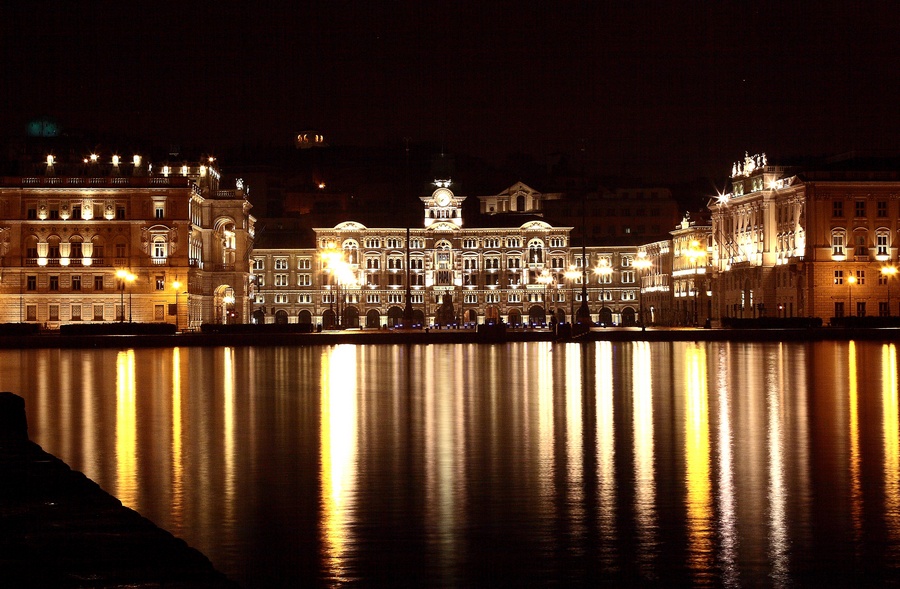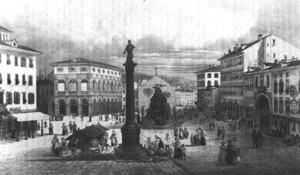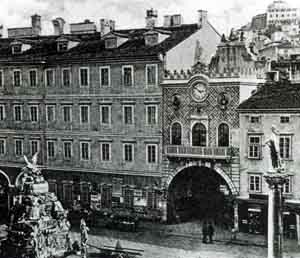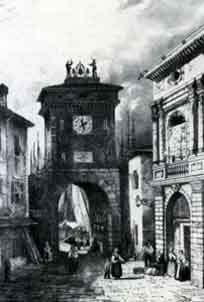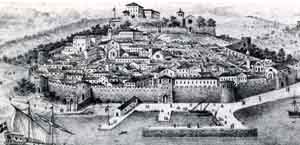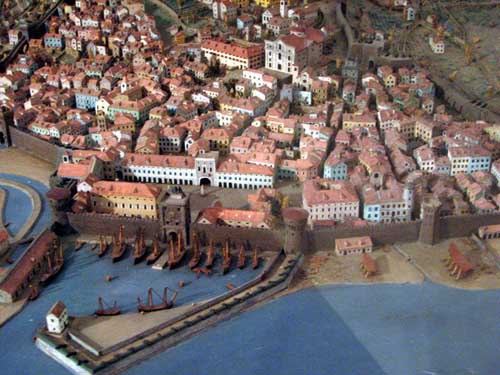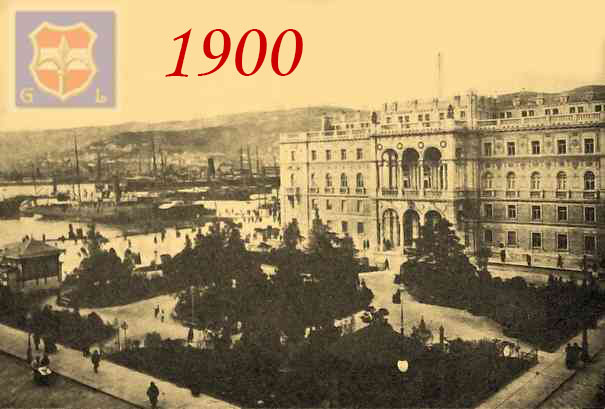Piazza dell’Unità d’Italia
Piazza dell’Unità d’Italia is today the largest square open to the sea in Europe.
It is defined as "the drawing room of Trieste" and for the people of Trieste it is the place to which they feel most connected as the whole city life pulsates here. Today it is a place for walks, for business meetings, for shows, celebrations and events as it was once a place for processions, executions and merry-go-rounds, in short, it is, and has always been, the center of daily life in the city.
The square was originally called Piazza San Pietro but was commonly called Piazza Grande until 1918 when it was called Piazza Unità in honor of the annexation of Trieste to Italy, after a short period in which it was called Piazza Francesco Giuseppe. Finally, on 25 April 1955, it was officially called with the current name of Piazza dell'Unità d'Italia by the then Mayor Gianni Bartoli, from Rovinj, who went down in history as the Mayor of difficult years, due to the hard historical moment that Trieste went through in that period.
Originally the square was, by extension, less than half of the current surface and was bounded by the Palazzo Pubblico or Palazzo del Magistrato which had a wooden loggia from the first half of the 1400s, then rebuilt in stone in 1686, and was to be located at the roughly where the faces of the municipal building are today.
The building essentially consisted of a large room, called stufa (stube) as the first stove for heating was placed here, where the Council of Forty met, which had jurisdiction in judicial matters and later the sessions were held here. of the City Council and public auctions. The building was enlarged in various stages, both to the right and to the left of the loggia, incorporating neighboring buildings and also housing the Public Library.
Two bronze busts depicting Duke Leopold III of Austria and Emperor Frederick III (1415 - 1493) were displayed on the facade of the building.
The building was demolished in 1871 to make way for the current Town Hall of Bruni and the clock set in the facade was transferred to the Municipality of Prosecco while the bell (dated 1470) was transported to the Church of San Giovanni e Pelagio in Guardiella to be stored in the thirties on its original site, ie in the bell tower of the church of San Michele al Carnale next to the Cathedral, from where it was taken in 1508 to end up on the roof of the municipal building.
The two bronze busts were moved inside the new Bruni palace from where they were removed in 1919 due to an order of the new Italian authority and probably destroyed.
In 1707 the Palazzo del Comune was built on the ashes of the old building which was destroyed by a fire, on the site occupied today by the Caffè degli Specchi.
The Palace extended with its arches towards the center of the square while the back overlooked the old port of Mandracchio. Its interior consisted of a huge hall, which was reached via a marble staircase, where the Major Council met and where fairs were hosted. Subsequently, boxes and a stage were added transforming the hall into a real theater which was called by various names: Teatro di San Pietro, Teatro Cesareo Regio, Teatro Nuovo, Teatro Grande and Teatro Comunale.
In front of the then Palazzo Pubblico (or the Magistrate's) stood the Clock Tower also called Torre del Porto or Torre del Mandracchio, which in practice was the door to the square that overlooked the ancient port of the city, called Mandracchio.
In practice, the Mandracchio was located in that space between the current Prefecture and the Palazzo del Lloyd, now paved with blue lights in his memory. The Tower was demolished in 1838.
Inside the arch there was an image of the Madonna Annunziata venerated by sailors. It is a 17th century canvas depicting the Madonna with Saints Sergio, Silvestro, Nicolò and Rocco. The canvas is now in the guardhouse of the castle of San Giusto. Also inside the arch there was a statue of St. John of Nepomuk, also very revered by the fishermen and sailors of the time and this statue today should be in a niche of the surrounding wall of the Scuola Allievi in Guardiella.
In 1474 the tower was modified for the first time and in 1517 the ancient door was embellished with a clock and two bronze Moors that marked the hours and that the people then baptized Micheze and Jacheze (or Mikez and Jakez) which should be a nice graphic rendition in dialect by Michele and Giacomo (from the Slovenian Mihec and Jakec). In 1700 the Moors were eliminated and in their place a three-light cell with three bells was built. The tower was demolished on September 24, 1838 and was the last tower of the ancient city walls to be demolished. A bell of the Torre del Mandracchio, dated 1241, lies in the Civic Museum after having been transferred for the first time from the Tower to the Church of San Pietro and San Rocco in Piazza Grande and subsequently to the Church of San Bartolomeo in Barcola together with the rose window as we will see below .
On either side of the Mandracchio Tower there was a building that housed the prisons (later the Town Hall described above) and on the other side the Osteria del Comune or Osteria del Porto, a building owned by the Municipality rented to an innkeeper. . In the second half of the 1700s, the building was raised by one floor to become the Locanda Grande, which in June 1768 housed the German archaeologist and art historian JJ Winckelmann (famous for having brought to light the remains of Pompeii) then murdered in a room of the same inn on June 8 of the same year. The inn had about forty rooms and a stable. On the ground floor there was the Carrara Coffee and the Guard Corps.
Next to the Locanda Grande, in 1780, the Plenary Palace designed by the architect Ulderico Moro on behalf of the wealthy merchant Plenario was found, which later became Palazzo Pitteri as the home and property of the scholar Riccardo Pitteri. The building later became the property of the Lloyd Adriatico insurance company.
The square also housed a Civic Chapel known as St. Peter's, built by the testamentary will of a Ghibelline exile, Pietro Onorati, who died in Trieste in 1367 and was located where Palazzo Model stands today, that is the first building on the right reaching the square from Piazza della Bag. In 1602 next to the church of San Pietro a second church was erected in honor of San Rocco, as a vote of the city for the terrible pestilence that was tormenting it. The two churches were later joined with a single roof and one of the three bells of the Torre del Mandracchio was added. In 1870 they were demolished but the central rose window, after being deposited in the Lapidary Garden, was reused to decorate the facade of the church of San Bartolomeo a Olomeo in Barcola which still displays it today.
In the area where Capo di Piazza is today there was the Porta Nuova or Porta di Vienna, demolished in 1780 while on the opposite side, about near the current Via San Sebastiano, there was the Porta Cavana.
Next to Palazzo Pitteri, the Vanoli Hotel was built in 1873 to a design by the architects Eugenio Geiringer and Giovanni Righetto. Today there is the Duca D’Aosta hotel, one of the most prestigious in the city and the Harry's Cafè restaurant overlooks the square.
Between 1881 and 1883 the imposing Palazzo del Lloyd Triestino (then Lloyd Austriaco di Navigazione) was erected to a Renaissance style project by the Viennese architect Heinrich von Ferstel, as a symbol of Trieste's lordship on the sea. The architect von Ferstel was one of the greatest professionals of the time, he was responsible for many architectural works in Vienna such as, to name a few, the building of the Austrian Museum of Art and Industry, the palace of Archduke Ludovico Vittorio in Schubertring and the Votive Church (Votivkirche).
The building occupied the space left free by the burial of the old squero di San Nicolò which for a period was used as a square used as a market. At the center of the façade overlooking the square, at the top, a sign now bears the writing "Lloyd Triestino" placed in the 1930s to replace a large Austro-Hungarian Lloyd coat of arms. The whole is dominated by two Winged Victories: the one on the left raises an oak branch symbol of strength and at his side a young man symbolizes work, the one on the right raises a laurel wreath symbol of glory flanked by a young man sitting on a boat that symbolizes the sea. On the parapet, from left to right, the statues of Aeolus (god of winds), Mercury (god of trade), Vulcan (prince of earthly fire) and Neptune (god of the seas) dominate.




